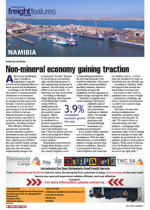As the Walvis Bay Corridor Group (WBCG) marks its 25th anniversary this year, the organisation continues to make significant strides in positioning the Port of Walvis Bay as a competitive and strategic gateway for cargo movement in southern Africa. Features Editor Liesl Venter sat down with Mbahupu Hippy Tjivikua, CEO of the WBCG, to discuss the group’s progress, regional logistics challenges, and the future of trade corridors in the region.LV: Which key corridors remain a strategic focus for the WBCG and why?M HT: The Walvis Bay–Ndola–Lubumbashi Corridor remains a key focus for us, as it supports trade with Zambia and the DRC and, by extension, Malawi and Zimbabwe. On the Namibian side, road infrastructure is in good condition. However, on the Zambian side, road conditions are inconsistent and not yet at the standard we would like. A significant challenge is the lack of rail connectivity between Namibia and Zambia, which should be a top priority.Cargo volumes between Namibia and Zambia are increasing steadily, and integrating a rail component would offer a much more efficient and cost-effective logistics solution. We’re looking at a stretch of about 800 km that needs rail infrastructure from Grootfontein to Katima Mulilo. The Trans-Kalahari Corridor is also very important for us. It has traditionally carried significant volumes for Botswana, especially with recent developments in western Botswana, where new copper mines are emerging. Previously, the corridor also supported coal exports, but volatility in coal prices has impacted those volumes.Then there’s the Trans-Oranje Corridor, which is a vital route for the Port of Lüderitz. This corridor handles manganese exports from South Africa’s Northern Cape.We’re expecting a new operator to come on board soon, and we anticipate volumes will double by the end of the year. In fact, operations are expected to begin in July, and warehouse facilities are currently under development. This is a very positive step that will help reshape Lüderitz as a logistics hub.LV: The WBCG has been working relentlessly for the past 25 years. How do you feel when you reflect on the organisation’s journey and achievements?M HT: It’s incredible to see what we’ve achieved over the past 25 years. We’ve built one of the best-managed corridors in the region. Our consistency, reliability and dedication have earned us not only the trust of stakeholders in Namibia but also recognition and credibility on a global scale. The reputation we’ve built has been the result of sustained effort and commitment over time.LV: What have been some of the key challenges you’ve faced along the way?M HT: One of the biggest challenges we’ve faced is that not everyone in the value chain fully understands or supports the commercial importance of the corridor. There’s sometimes a disconnect, especially among certain state agencies, where rigid regulatory approaches can create non-tariff barriers (NTBs) that hinder trade.We also face a lack of harmonisation across the region. Regulatory inconsistencies, outdated laws, and overregulation can seriously constrain movement. For example, we’ve seen issues with outdated fertiliser regulations that were originally copied from South African law and were designed for domestic consumption. Now that fertiliser transit volumes have grown, those outdated rules are no longer fit for purpose, but instead of adapting, we risk halting trade unnecessarily.LV: What steps do you believe need to be taken to address these challenges and improve efficiency in the region?M HT: We’re not advocating for a relaxation of standards or illicit activity – far from it. But we do need to modernise and align our systems. There’s still rigidity in how some agencies operate. For instance, requiring fertiliser to be packed in one-ton bags at the quayside instead of bulk handling makes operations unnecessarily complex and expensive. Likewise, frozen food that’s simply transiting Namibia is sometimes blocked under domestic restrictions, even though it’s not intended for local consumption.Meanwhile, ports like Beira have responded to these dynamics, expanding their cold chain infrastructure and attracting cargo that Namibia could have handled. We’re trying to encourage our counterparts to consider best practices across the region. The goal is not to bypass regulations, but to work more collaboratively, enabling trade while maintaining compliance. We must be facilitators – not blockers – of legitimate trade.LV: What factors do you believe have contributed to Namibia’s success as a reliable logistics corridor and how do you see its role evolving in the future?M HT: Namibia’s success has been built on its reputation for safety, security and efficiency. Operators have peace of mind knowing they can move cargo through Namibia with reliable turnaround times, which has been a key contributor to our growth. These are crucial elements that set us apart and will continue to shape our future.We need to keep positioning Namibia as a regional logistics hub, but this will take time, especially when it comes to expanding intra-African trade. For example, we must develop port facilities that cater to growing demand, such as for agro-processed products from countries like Nigeria, looking to move goods into southern Africa through Walvis Bay.The growing interest we’re seeing from global partners is a testament to the stability of our country. Namibia’s political environment offers certainty and continuity. When our president passed away, the seamless transition to a new leader within 12 hours, without disruption, speaks volumes about the stability we offer. We recently had Presidential and national elections where Namibia elected Her Excellency Dr Netumbo Nandi-Ndaitwah, who has made history as the first democratically elected female president. The elections were free and fair, without violence. This is somethingthat resonates with businesses and strengthens our position as a trusted trade partner. LV

